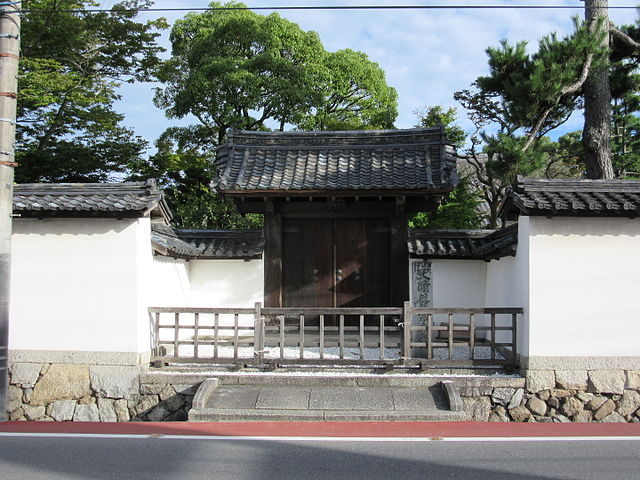Iga City (伊賀市, Iga-shi), formerly known as Iga-Ueno (伊賀上野), is a small city located in the eastern Kansai region. Its claim to fame is being one of the home bases of the ninja, the spies employed by the shoguns and their rivals in the feudal eras. Today, their traditions are preserved and demonstrated at the excellent Iga-ryu Ninja Museum. Iga City is also the home of the Ueno Castle, and multiple monuments to the haiku poet Basho (松尾 芭蕉, Matsuo Bashō, 1644-1694), who was born in this city.
Main Attractions
1) Iga-ryu Ninja Museum: A comprehensive museum of the Iga ninja, with live demonstration shows.
 |
| No machine-readable author provided. Outside147~commonswiki assumed (based on copyright claims). [GFDL, CC-BY-SA-3.0 or CC BY-SA 2.5], via Wikimedia Commons |
3) Ueno Castle: A feudal castle, traditionally rebuilt in the 1930s.
4) Basho Memorial Museum: A small museum devoted to Bashō's poems and travels.
5) Danjiri Kaikan: A museum about the local Ueno Tenjin Festival (23-25 October), housing some of its floats.
 |
| By Yanajin33 [CC BY-SA 3.0], from Wikimedia Commons |
 |
| By Opqr [CC BY-SA 4.0], from Wikimedia Commons |
Orientation
Most of the city's attractions are within 15 minutes' walking distance of Ueno-shi Station, on the Iga Railway line. The Ninja Museum, Ueno Castle, Danjiri Festival Museum, and Basho Museum all lie in or around Ueno Park, the entrance of which is 250m (850ft.) north of the station.
Access
Iga can be accessed in about two hours from Osaka, Kyoto, or Nagoya, by either the JR or Kintetsu railway networks, followed by a shorter ride on the Iga Railway. Multiple transfers are required when going by train; for example, part of JR's Kansai Main Line has not been electrified, so you will need to switch between electric and diesel trains for different sections. Direct highway buses are also available between the above cities, although their service can be infrequent depending on where you are departing from.
From Osaka, take the JR Yamatoji (Q) line from Osaka or JR-Namba to Kamo Station (Q39, 65 minutes), continue on the Kansai Main Line (V) to Iga-Ueno Station (35 minutes, total ¥1,520), then take the Iga Railway to Ueno-shi (7 minutes, ¥260). The Japan Rail Pass is valid on all but the Iga Railway section. Alternately, take the Kintetsu Osaka (D) line from Osaka-Uehommachi to Iga-Kambe (D52, 90 minutes, ¥1,160), then take the Iga Railway to Ueno-shi (25 minutes, ¥370). Limited-express trains can shave up to half an hour off the time, but cost ¥920 extra, and most trains require transferring to a local train at Nabari Station (D49). Additionally, on weekends and holidays only, there are four buses per day between Ueno-shi and Osaka (80 minutes, ¥1,800) or Shin-Osaka (100 minutes, ¥1,800) stations. More information: (Japanese).
From Kyoto, take the JR Nara (D) line from Kyoto to Kizu Station (D19, Local: 40-60 minutes), transfer on the Yamatoji line to Kamo (5 minutes), and continue on the Kansai Main Line to Iga-Ueno Station (35 minutes, total ¥1,170), then take the Iga Railway to Ueno-shi. Alternately, take the JR Biwako (A) line from Kyoto to Kusatsu Station (A24, 20-25 minutes), the Kusatsu (C) line to Tsuge (45 minutes), and the Kansai Main Line to Iga-Ueno (15 minutes, total ¥1,170), then take the Iga Railway to Ueno-shi. Again, the Japan Rail Pass is valid on all but the Iga Railway. As of 2019, there are no longer any direct buses between Iga and Kyoto.
From Nagoya, take the JR Kansai Rapid (CJ) line from Nagoya to Kameyama Station (CJ17, 60 minutes), continue on the Kansai Main Line to Iga-Ueno Station (45 minutes, total ¥1,690), then take the Iga Railway to Ueno-shi (7 minutes, ¥260). Again, the Japan Rail Pass is valid on all but the Iga Railway. Alternately, take the Kintetsu Nagoya (E) line from Kintetsu-Nagoya to Ise-Nakagawa (E61, 80 minutes), then the Kintetsu Osaka line to Iga-Kambe (35 minutes, ¥1,590), and then take the Iga Railway to Ueno-shi. Limited-express trains can shave up to half an hour off the time, but cost an extra ¥920 (to Ise-Nakagawa) to ¥1,340 (full trip). Additionally, there are eight buses per day between Ueno-shi and the Meitetsu Bus Centre at Nagoya Station (100 minutes, ¥2,000). More information: (Japanese).
A discount ticket introduced in 2019, the Iga Ninja Liner Ticket, includes bus fare from Nagoya to Iga-Ueno, and admission to the Iga-ryu Ninja Museum and Danjiri Museum. The one-way version costs ¥3,000, and the round-trip version costs ¥4,600. It may be purchased from the Meitetsu Bus Centre at Nagoya Station, or at Chubu Centrair Airport. More information: (Japanese)





